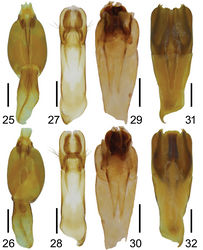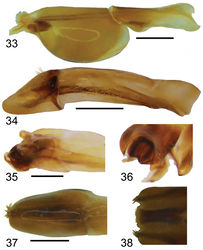Bolbochromus jengi
| Notice: | This page is derived from the original publication listed below, whose author(s) should always be credited. Further contributors may edit and improve the content of this page and, consequently, need to be credited as well (see page history). Any assessment of factual correctness requires a careful review of the original article as well as of subsequent contributions.
If you are uncertain whether your planned contribution is correct or not, we suggest that you use the associated discussion page instead of editing the page directly. This page should be cited as follows (rationale):
Citation formats to copy and paste
BibTeX: @article{Li2019ZooKeys842, RIS/ Endnote: TY - JOUR Wikipedia/ Citizendium: <ref name="Li2019ZooKeys842">{{Citation See also the citation download page at the journal. |
Ordo: Coleoptera
Familia: Geotrupidae
Genus: Bolbochromus
Name
Bolbochromus jengi Li & Krikken sp. n. – Wikispecies link – ZooBank link – Pensoft Profile
Material examined
Holotype male. The holotype (glued on card) with the following information on the label: Philippines: Babuyan Islands, Cagayan Province, Is. Camiguin, Panan, 18-20.IV.2012, FIT, ML Jeng, H. Cahilo leg. The holotype is deposited at the National Museum of Natural Science, Taichung, Taiwan (NMNS). Paratypes: 12 males and 9 females: PHILIPPINES: Luzon, Quezon Prov. Polillos Is., Brgy Tamulaya, Sitio Anibong nr. Stream, 12-14. V. 2013, 3FITs, M.-L. Jeng leg (1 female at NMNS); Philippines: Luzon, Cagayan Province, Sta. Praxedes Macatel Falls, 24-26. IV. 2012, FIT, ML Jeng, H Cahilo leg. (1 male at CCLI); Philippines: Luzon, Cagayan Province, Sta. Ana, Nangramoan, 17-22. IV. 2012, FIT, ML Jeng, H Cahilo leg. (1 female at CCLI); Philippines: Dinagat Is., Dinagat Province, Mncp. Loreto Brgy. Panamauan, mine field near stream, 120m asl, 10°25'49"N, 125°37'42"E, 21-22.III.2017, by FITs, ML Jeng, YT Wang, H Cahilog (1 female at NMNS); Philippines: Luzon, Ilocos Norte Province, Adams, 7km N to Adams, near stream, 240m asl, 18°31'35"N, 120°54'47"E, 03-06.IV.2017, by FITs, ML Jeng, H Cahilog (2 males and 1 female at NMNS, 2 males at CCLI); ditto, 01-03.IV.2017 (1 female at CCLI); Philippines: Luzon, Kalinga Prov., Balbalan Mnp. Mabunol, near stream, 995m asl, 17°29'41"N, 121°12'12"E, 21-24.V.2018, by FITs, ML Jeng, TR Chen, H Cahilog (3 males at CCLI; 1male and 1 female at Universitet Zoologisk Museum, Copenhagen, Denmark; 1male and 1 female at Museum für Naturkunde der Humboldt Universität, Berlin, Germany; 1male and 1 female at the Natural History Museum, London, UK; 1 male and 1 female at Naturhistorisches Museum, Wien, Austria).
Type locality
Panan, Camiguin Island, Babuyan Islands, Cagayan Province, northern Philippines.
Description
Males (Figs 5, 6, 15). Body length 9.8–10.3 mm; greatest width 6.0-6.4 mm. Form ovate, sides subparallel. Body overall black with dorsum shiny. Antennal clubs yellowish brown to black. Head: Labrum with anterior margin shallowly concave centrally, sides notched, surface coarsely, transversely rugose. Labrum and mandibles visible beyond clypeus when viewed dorsally. Clypeus subtrapezoidal, anterior margin beaded with or without a small convexity at middle, protrusion at basal angle moderately to weakly developed, surface coarsely, transversely rugose. Clypeofrontal suture vaguely indicated. Frons with a small conical convexity at center, tip rounded or weakly bilobed. Eye small, canthus wide and simple (Fig. 21). Thorax: Anterior side of pronotum behind head sharply declivous with a shallow fossa either side of midline, midline deeply indented on basal half along with coarse punctures. Surface of pronotum with tiny, secondary punctures sparsely distributed evenly, coarse punctures in fossae and both sides of pronotum, sides of basal half of midline and base of pronotum almost impunctate. Fovea vestigial. Scutellum with scattered secondary punctures, slightly longer than wide medially. Elytron: With 7 punctate striae between suture and humeral umbone, punctures coarse, stria 2 interrupted by stria 1 not reaching base, stria 5 terminated in length subequal to stria 2; intervals 1, 3 and 4 more convex and wider than others, interval 2 less convex than others. Legs: Protibia with 9 distinct teeth on outer margin, apical 3 teeth protruding, tip of apical tooth sharp and curved outwardly. Male genitalia: Parameres one-third as long as basal piece, swollen when viewed laterally, strongly sclerotized at base (Figs 27, 28, 34); surface sparsely to moderately punctate with a tuft of long setae located at dorsal base of each paramere. Median lobe bilobate with dorsal sclerite largely reduced within temones; lateral sclerites elongate with apex fimbriate-like; supporting sclerites absent. Internal sac absent. Temones long, strongly sclerotized. Basal piece with apical portion asymmetrical, dorsal base with a few setiferous punctures.
Females
Similar to male with minor differences of anterior side of pronotum behind head less declivous and fossa in small-sized individual hardly observed, elytral interval between stria 1 and 2 absent, scutellum with one or two coarse punctures, protibia with 10 outer margin teeth and apical tooth of protibia more curved.
Diagnosis
Bolbochromusjengi sp. n. is similar to B.celebensis Boucomont, 1914 in sharing the overall black body color but it can be distinguished based on the following combination of characters: anterior side of pronotum behind head sharply declivous with a shallow fossa either side of midline (anterior side of pronotum behind head smoothly declivous without fossa at sides of midline in B.celebensis); elytral intervals 1, 3 and 4 more convex than others, interval 2 less convex than others (intervals 1–5 equally convex); elytron with 7 striae between suture and humeral umbone (5 striae in B.celebensis); elytral striae 2 and 5 not reaching base (all striae reaching base in B.celebensis); and male genitalia with a tuft of long setae located at dorsal base of each paramere (glabrous in B.celebensis). As the last character above-mentioned on male genitalia of B.jengi can also be found in the Negros Island species, B.hirokawai indicating their close relationship though the latter species has its dorsal body color yellowish brown to reddish yellow or partly dark brown which can be easily separated from B.jengi sp. n.
Distribution
Luzon and neighboring islands, northern Philippines (Fig. 39).
Etymology
Bolbochromusjengi sp. n. is named after Dr. Ming-Luen Jeng, the former curator of the National Museum of Natural Science, Taichung, Taiwan, who collected and provided the materials used in this study.
Remarks
Bolbochromusjengi sp. n. has its distribution over the neighboring small islands (Map 1) of Luzon and probably also occurs throughout the main island. A noticeable female was collected from Dinagat Island (Map 1), approximately 700 km SE of the nearest known locality of species in Luzon. Further investigation of the species distribution is needed.
Original Description
- Li, C; Krikken, J; Wang, C; 2019: Review of the genus Bolbochromus (Coleoptera, Scarabaeoidea, Geotrupidae, Bolboceratinae) in the Philippines ZooKeys, 842: 135-152. doi
Images
|





